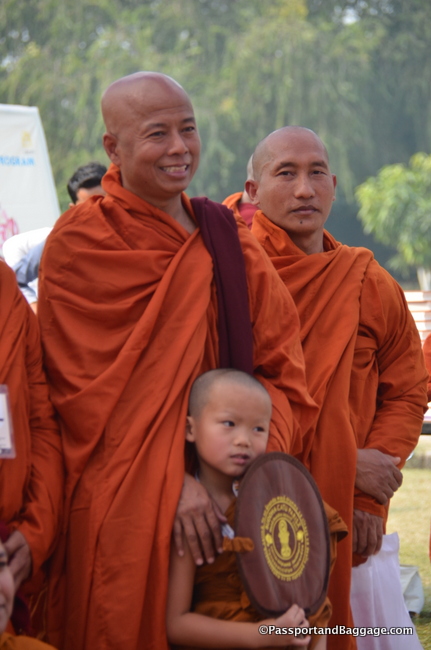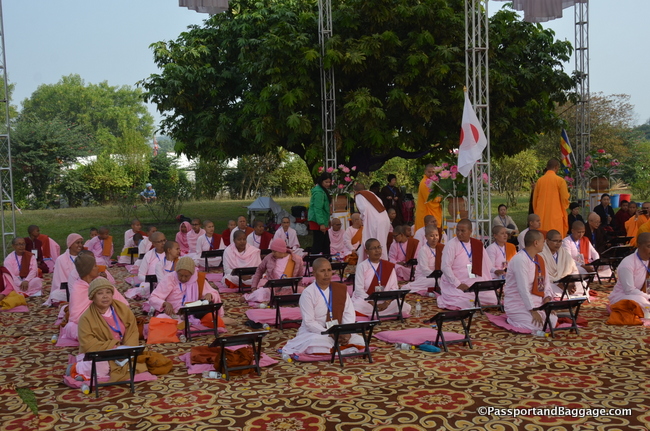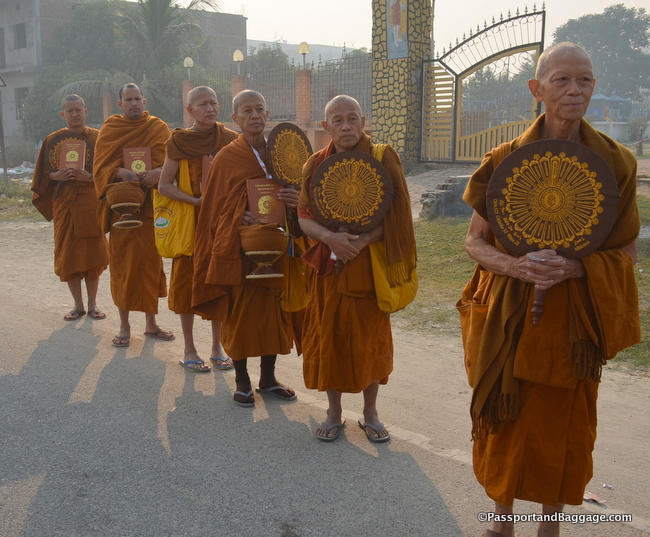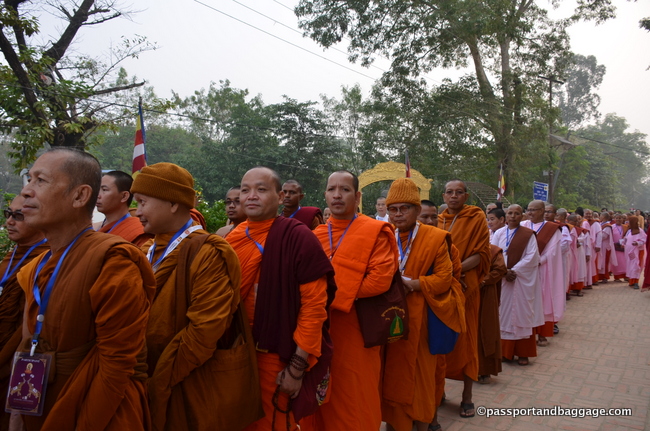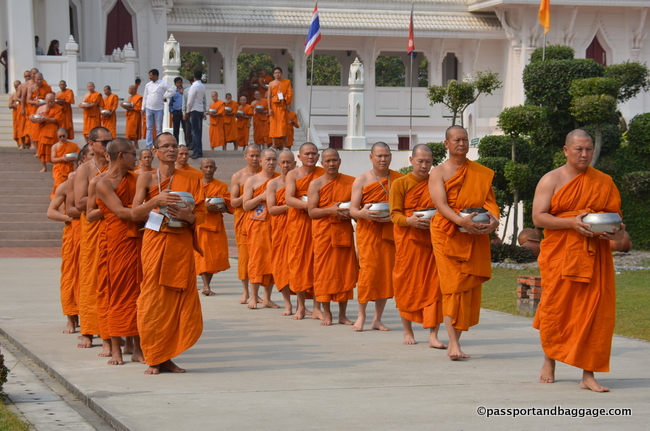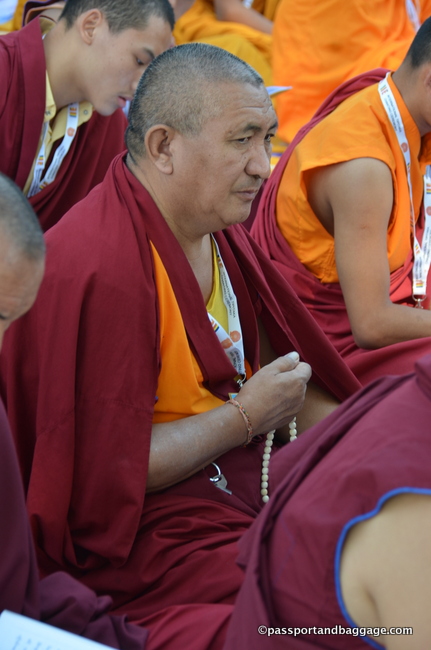November 2018
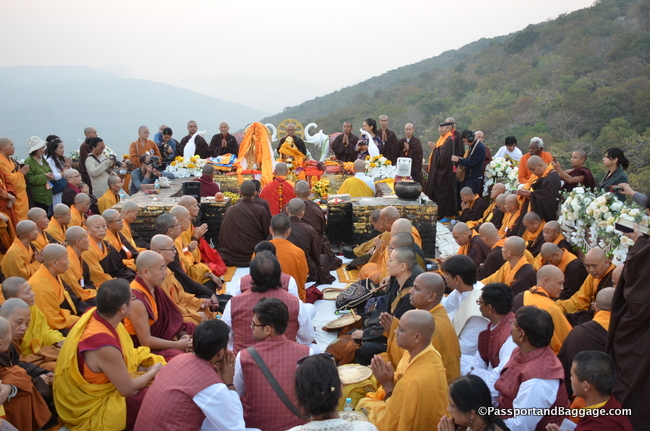
An international gathering of monks on Vultures Peak in Rajgir is a display of the many robes that monks wear
The robes of Buddhist monks and nuns are part of a tradition that goes back to the time of the historical Buddha. The first monks wore robes patched together from rags, as did many mendicant holy men in India at the time.
As the wandering community of disciples grew, the Buddha found that some rules about robes were necessary. These are recorded in the Vinaya-Pitaka of the Pali Canon or Tipitaka.
This article is primarily about the robes of the Theravadan tradition.
Robe Cloth
The Buddha taught the first monks and nuns to make their robes of “pure” cloth, which meant cloth that no one wanted.
Any part of the cloth that was unusable was trimmed away, and the cloth was washed. It was dyed by being boiled with vegetable matter — tubers, bark, flowers, leaves — and spices such as turmeric or saffron, which gave the cloth a yellow-orange color. This is the origin of the term “saffron robe.”
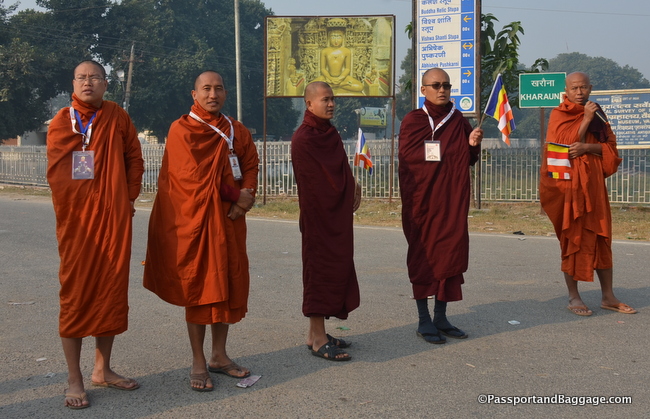
Theravada monks of southeast Asia still wear spice-color robes today, in shades of curry, cumin, and paprika as well as blazing saffron orange.
Now robes are made from cloth that is donated or purchased.
The Rice Paddy
According to the Vinaya-Pitaka, the Buddha asked his chief attendant and cousin Ananda to design a rice paddy pattern for the robes. Ananda sewed strips of cloth representing rice paddies into a pattern separated by narrower strips to represent paths between the paddies.
To this day, many of the individual garments worn by monks of all schools are made of strips of cloth sewn together in this traditional pattern. It is often a five-column pattern of strips, though sometimes seven or nine strips are used
The Triple and Five-Fold Robes
The robes worn by Theravada monks and nuns of southeast Asia today are thought to be unchanged from the original robes of 25 centuries ago. The robe has three parts:
The uttarasanga is the most common robe. It is sometimes also called the kashaya robe. It is a large rectangle, about 6 by 9 feet. It can be wrapped to cover both shoulders, but most often it is wrapped to cover the left shoulder but leave the right shoulder and arm bare.
The antaravasaka is worn under the uttarasanga. It is wrapped around the waist like a sarong, covering the body from waist to knees.
The sanghati is an extra robe that can be wrapped around the upper body for warmth. When not in use, it is sometimes folded and draped over a shoulder.
 The original nuns’ robe consisted of the same three parts as the monks’ robe, with two additional pieces, making it a “five-fold” robe. Nuns wear a bodice (samkacchika) under the utterasanga, and they carry a bathing cloth (udakasatika).
The original nuns’ robe consisted of the same three parts as the monks’ robe, with two additional pieces, making it a “five-fold” robe. Nuns wear a bodice (samkacchika) under the utterasanga, and they carry a bathing cloth (udakasatika).
Today, Theravada women’s robes are usually in muted colors, such as white or pink, instead of bright spice colors.
Fans
A fan is used by a monk during the Precepts and Refuges ceremony as well as talks about the Dhamma. The monk will hold the fan before the face to de-emphasize the identity of the monk. This is so that precepts are given on a more symbolic, rather than personal level. The fan can also be used as a ‘divide’ when a monk speaks with a woman.
The Begging Bowl
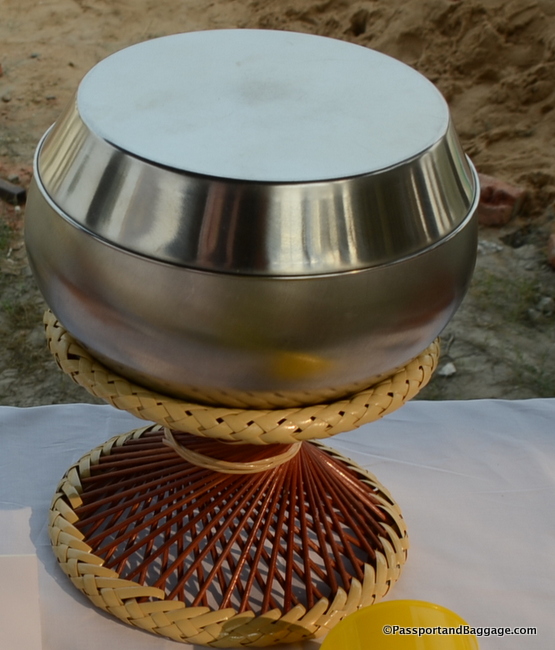 The begging bowl or alms bowl is one of the simplest but most important objects in the daily lives of Buddhist monks and nuns. It is primarily a practical object, used as a bowl in which to collect alms (either money or food) from lay supporters.
The begging bowl or alms bowl is one of the simplest but most important objects in the daily lives of Buddhist monks and nuns. It is primarily a practical object, used as a bowl in which to collect alms (either money or food) from lay supporters.
But the begging bowl also has symbolic significance associated with the historical Buddha. According to one legend, when he began meditating beneath the Bodhi Tree, a young woman offered him a golden bowl filled with rice, thinking he was the divinity of the tree. He divided the rice into 49 portions, one for each day until he would be enlightened, and threw the precious bowl into the river.
This and other legends have made the simple begging bowl a symbol of the Buddha’s teachings on nonattachment. The Vinaya states that monks may use bowls made of either iron or clay, and they can be small, medium, or large.
Lay People
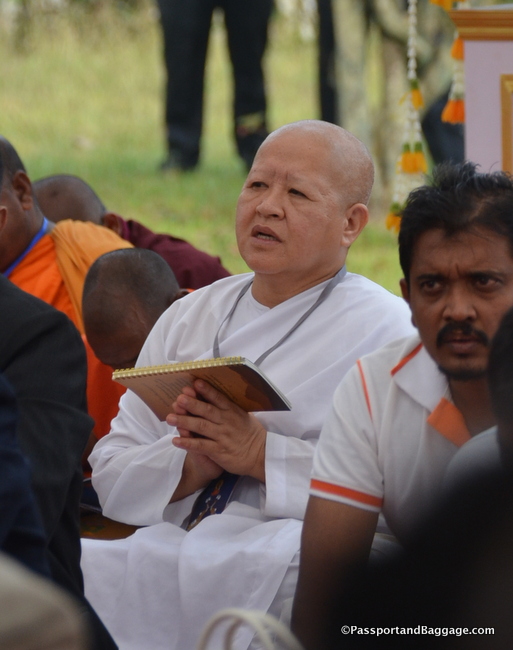 This is my friend Maechi Anita. Maechis are Buddhist laywomen in Thailand who have dedicated their lives to religion, vowing celibacy, living an ascetic life and taking the Eight or Ten Precepts (i.e., more than the Five Precepts taken by laypersons). They occupy a position somewhere between that of an ordinary lay follower and an ordained monastic.
This is my friend Maechi Anita. Maechis are Buddhist laywomen in Thailand who have dedicated their lives to religion, vowing celibacy, living an ascetic life and taking the Eight or Ten Precepts (i.e., more than the Five Precepts taken by laypersons). They occupy a position somewhere between that of an ordinary lay follower and an ordained monastic.
It is still illegal for women to take full ordination as a bhikkhuni in Thailand because of a 1928 law created by the Supreme Patriarch of Thailand. He based this on the fact that Gautama Buddha allowed senior bhikkhunis to initiate new women into the order. Citing the belief that the Theravada bhikkhuni sangha had died out centuries earlier, the patriarch commanded that any Thai bhikkhu who ordained a female “is said to conduct what the Buddha has not prescribed, to revoke what the Buddha has laid down, and to be an enemy of the holy Religion…”.
Lay people also wear white. There is no record of Buddha advocating that his lay followers wear any particular type of clothing, but they are often referred to as `lay disciples dressed in white’. From the time of the Buddha, lay Buddhists favored clothing made out of plain undyed fabric. Such clothes would symbolize purity and simplicity and also emphasize the equality between Buddhists by diminishing the distinction between rich and poor.
*


